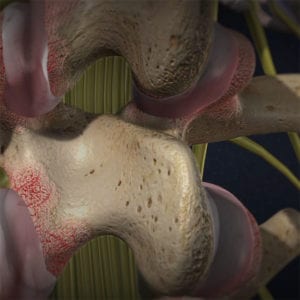The facet joints of the spine, located in the back portion of the vertebrae, provide stability and control to the motion of the spine. Even though little movement takes place between each vertebrae, the complete chain of facet joints give the spine its flexibility. When these facet joints are injured, inflamed, or begin to deteriorate, patients can experience mild to extreme discomfort, greatly limiting their range of motion. This condition, when occurring in the facet joints of the lower back, is often called lumbar facet joint syndrome.
 Repetitive movement, trauma, or arthritic changes can all potentially cause lumbar facet joint syndrome. It can often develop after trauma to the spine, in cases where there is a direct spinal injury. It can also occur as a secondary condition for patients also suffering from degenerative disc disease. When the vertebral disc is damaged or loses cushioning, the facet joint is allowed less space to move, resulting in joint degeneration. Poor posture can also contribute to the development of lumbar facet joint syndrome. The natural curve of the lower back, referred to as the lumbar lordosis, is designed to handle only a certain amount of sustained stress. When this curve is exaggerated, excessive stress can be placed on the facet joints, causing inflammation or degeneration.
Repetitive movement, trauma, or arthritic changes can all potentially cause lumbar facet joint syndrome. It can often develop after trauma to the spine, in cases where there is a direct spinal injury. It can also occur as a secondary condition for patients also suffering from degenerative disc disease. When the vertebral disc is damaged or loses cushioning, the facet joint is allowed less space to move, resulting in joint degeneration. Poor posture can also contribute to the development of lumbar facet joint syndrome. The natural curve of the lower back, referred to as the lumbar lordosis, is designed to handle only a certain amount of sustained stress. When this curve is exaggerated, excessive stress can be placed on the facet joints, causing inflammation or degeneration.
In most cases, lumbar facet joint syndrome can be treated through non-surgical methods. Many patients suffering from lumbar facet joint syndrome can find relief with the help of a pain management specialist. The physicians at Segura Neuroscience & Pain Management are trained in the use of specialized pain management treatments, such as lumbar facet radiofrequency neurotomy and medial branch blocks.
